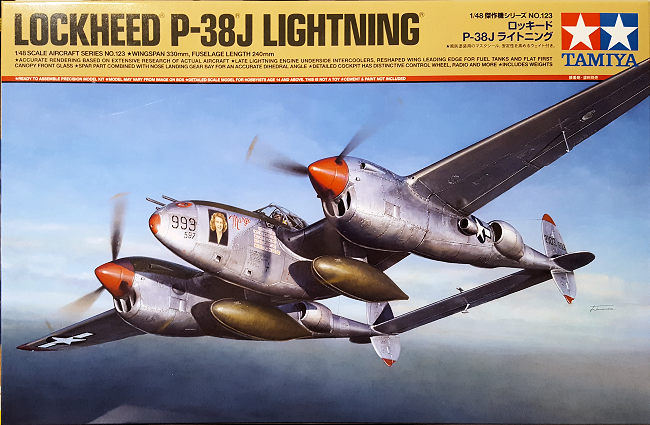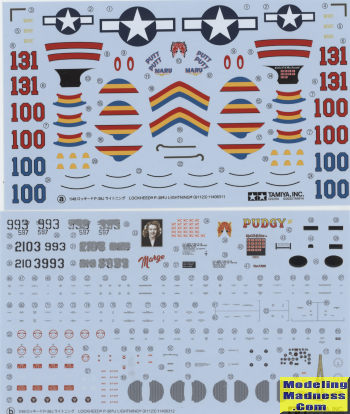
| KIT #: | 61123 |
| PRICE: | $50.00 delivered |
| DECALS: | Three options |
| REVIEWER: | Scott Van Aken |
| NOTES: | 2022 release |

| HISTORY |
The P-38J was introduced in August 1943. The turbosupercharger intercooler system on previous variants had been housed in the leading edges of the wings and had proven vulnerable to combat damage and could burst if the wrong series of controls was mistakenly activated. In the P-38J series, the streamlined engine nacelles of previous Lightnings were changed to fit the intercooler radiator between the oil coolers, forming a "chin" that visually distinguished the J model from its predecessors. While the P-38J used the same V-1710-89/91 engines as the H model, the new core-type intercooler more efficiently lowered intake manifold temperatures and permitted a substantial increase in rated power. The leading edge of the outer wing was fitted with 55 US gal (210 L) fuel tanks, filling the space formerly occupied by intercooler tunnels, but these were omitted on early P-38J blocks due to limited availability.
The final 210 J models, designated P-38J-25-LO, alleviated the compressibility problem through the addition of a set of electrically actuated dive recovery flaps just outboard of the engines on the bottom centerline of the wings. With these improvements, a USAAF pilot reported a dive speed of almost 600 mph (970 km/h), although the indicated air speed was later corrected for compressibility error, and the actual dive speed was lower. Lockheed manufactured over 200 retrofit modification kits to be installed on P-38J-10-LO and J-20-LO already in Europe, but the USAAF C-54 carrying them was shot down by an RAF pilot who mistook the Douglas transport for a German Focke-Wulf Condor. Unfortunately, the loss of the kits came during Lockheed test pilot Tony LeVier's four-month morale-boosting tour of P-38 bases. Flying a new Lightning named Snafuperman, modified to full P-38J-25-LO specifications at Lockheed's modification center near Belfast, LeVier captured the pilots' full attention by routinely performing maneuvers during March 1944 that common 8th Air Force wisdom held to be suicidal. It proved too little, too late, because the decision had already been made to re-equip with Mustangs.
The P-38J-25-LO production block also introduced hydraulically boosted ailerons, one of the first times such a system was fitted to a fighter. This significantly improved the Lightning's rate of roll and reduced control forces for the pilot. This production block and the following P-38L model are considered the definitive Lightnings, and Lockheed ramped up production, working with subcontractors across the country to produce hundreds of Lightnings each month.
| THE KIT |
 Instructions
are a large booklet with Tamiya paint number references. The 55 construction
steps are clearly drawn with hints where needed. Three markings options are
provided and the placement instructions are huge fold out sheets. All three
are overall unpainted metal with olive drab nose anti-glare panels. The
planes are all flown by aces. There is Richard Bong's "Marge", Charles
McDonald's "PuttPutt Maru", and Tommy McGuire's "Pudgy III". The decals are
very nicely done and include chrome markings (which show up as black on the
scan). On some of the options, the red trim must be painted.
Instructions
are a large booklet with Tamiya paint number references. The 55 construction
steps are clearly drawn with hints where needed. Three markings options are
provided and the placement instructions are huge fold out sheets. All three
are overall unpainted metal with olive drab nose anti-glare panels. The
planes are all flown by aces. There is Richard Bong's "Marge", Charles
McDonald's "PuttPutt Maru", and Tommy McGuire's "Pudgy III". The decals are
very nicely done and include chrome markings (which show up as black on the
scan). On some of the options, the red trim must be painted. | CONCLUSIONS |
| REFERENCES |
https://en.wikipedia.org/wiki/Lockheed_P-38_Lightning#P-38J,_P-38L
January 2023 Copyright
ModelingMadness.com. All rights reserved. No reproduction in part or in whole
without express permission. If you would like your product reviewed fairly and fairly quickly, please
contact
the editor or see other details in the
Note to
Contributors.